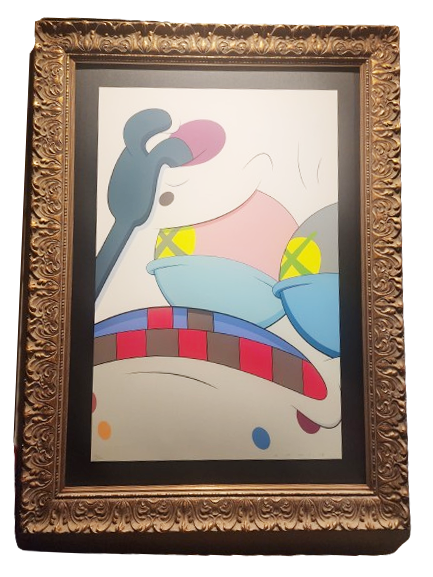
Gray/Grey
-

Kaws- Brian Donnelly Untitled from Blame Game- #10 Hand on Brow Silkscreen Print by Kaws- Brian Donnelly
Untitled from Blame Game- #10 Hand on Brow Hand-Pulled 11-Color Silkscreen Print on Saunders Waterford Hi-White Paper by Artist Kaws- Brian Donnelly Street Art Limited Edition Artwork. 2014 Signed & Numbered Limited Edition of 100 Artwork Size 23x35 Framed With a Large Custom Frame and Mat, Slight Feather Scuff To Lower Middle White. KAWS (b. 1974) Untitled from Blame Game, 2014 Screenprint in colors on Saunders Waterford Hi-White paper 35 x 23 inches (88.9 x 58.4 cm) (sheet) Ed. 100 Signed, numbered, and dated in pencil along the lower edge. Published by Pace Prints, New York The Expressive Nuance of KAWS' "Untitled from Blame Game - #10 Hand on Brow" The "Untitled from Blame Game - #10 Hand on Brow" stands as a significant piece within the oeuvre of KAWS, the artistic alias of Brian Donnelly. This piece is part of a limited series, a hand-pulled 11-color silkscreen print on Saunders Waterford Hi-White paper, known for its exceptional quality and resilience. The artwork, measuring 35 x 23 inches, is one of a limited edition set of 100, each signed, numbered, and dated by the artist in pencil along the lower edge, showcasing his direct involvement and personal touch in each piece. Released in 2014 and published by Pace Prints in New York, this work is framed within a large custom frame and mat, which elegantly encases the artwork and enhances its display. The "Hand on Brow" motif featured in print indicates KAWS' unique and recognizable visual language, frequently including bold colors, graphic shapes, and the reimagined characters that have become central to his art. The slight feather scuff to the lower middle white of the print may suggest the hands-on process involved in creating these works, emphasizing their handmade nature and the authenticity of the screen printing process. KAWS: Bridging Street Art and the Fine Art Sphere KAWS' journey from a graffiti artist tagging the streets of Jersey City to a global art phenomenon encapsulates the transformative power of street pop art and its ability to permeate the fine art world. His background in graffiti is evident in the freeform and expressive quality of his work, yet there is a sophistication to his approach that aligns with delicate art sensibilities. His "Untitled from Blame Game - #10 Hand on Brow" vividly represents this crossover, presenting a visual dialogue that is accessible yet complex, playful yet profound. Using an 11-color palette in the silkscreen process is particularly noteworthy, allowing KAWS to layer colors with precision and create images with depth and vibrancy. The choice of Saunders Waterford Hi-White paper reflects his commitment to quality, as it is a preferred substrate for fine art prints due to its superior texture and durability. Like many in KAWS' body of work, this piece is a sophisticated confluence of street art's edginess and pop art's mass appeal. Cultural Resonance of KAWS' Limited Edition Prints KAWS' prints, especially those within the "Blame Game" series, resonate culturally due to their commentary on social constructs and individual experience. The recurring themes in his work, including isolation, companionship, and contemplation, are universally relevant, allowing his art to speak to a diverse audience. His "Untitled from Blame Game - #10 Hand on Brow" encapsulates these themes, employing his iconic crossed-out eyes and abstracted figures to invite introspection and emotional response. As a limited edition piece, this artwork occupies a special place in street pop and graffiti art narratives. Collectors and enthusiasts value KAWS' prints for their artistic merit, rarity, and investment potential. The art of KAWS, particularly pieces like "Untitled from Blame Game - #10 Hand on Brow," continues to influence the trajectory of street-inspired art, commanding attention in urban environments and refined gallery spaces. In conclusion, "Untitled from Blame Game - #10 Hand on Brow" is a testament to KAWS' masterful blend of street art's spontaneity with the calculated craft of fine art printmaking. This piece symbolizes the artist's capacity to engage with viewers on multiple levels, offering a visual feast that is as thought-provoking as aesthetically pleasing. As street pop art continues to evolve, the work of KAWS is a pivotal point of reference, blurring the lines between subcultures and mainstream art forms.
$29,415.00


